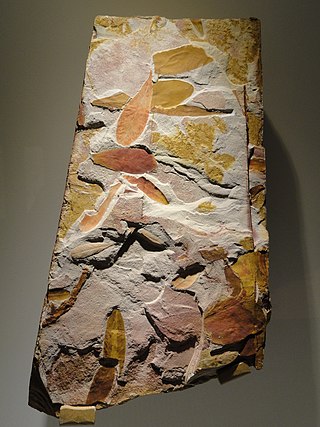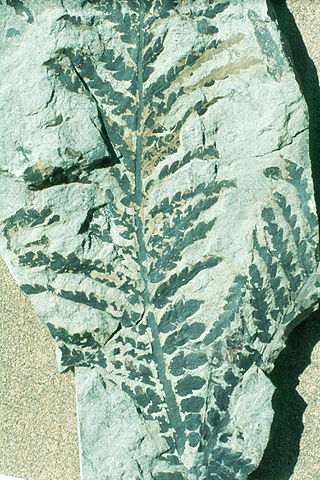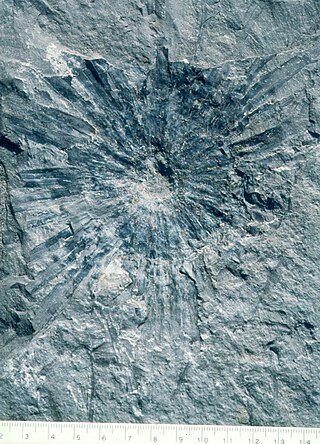
The Triassic is a geologic period and system which spans 50.5 million years from the end of the Permian Period 251.902 million years ago (Mya), to the beginning of the Jurassic Period 201.4 Mya. The Triassic is the first and shortest period of the Mesozoic Era and the seventh period of the Phanerozoic Eon. Both the start and end of the period are marked by major extinction events. The Triassic Period is subdivided into three epochs: Early Triassic, Middle Triassic and Late Triassic.

The Siberian Traps are a large region of volcanic rock, known as a large igneous province, in Siberia, Russia. The massive eruptive event that formed the traps is one of the largest known volcanic events in the last 500 million years.

Glossopteris is the largest and best-known genus of the extinct Permian order of seed plants known as Glossopteridales. The name Glossopteris refers only to leaves, within the framework of form genera used in paleobotany.

Isoetales, sometimes also written Isoëtales, is an order of plants in the class Lycopodiopsida.

In the geologic timescale, the Middle Triassic is the second of three epochs of the Triassic period or the middle of three series in which the Triassic system is divided in chronostratigraphy. The Middle Triassic spans the time between 247.2 Ma and 237 Ma. It is preceded by the Early Triassic Epoch and followed by the Late Triassic Epoch. The Middle Triassic is divided into the Anisian and Ladinian ages or stages.
Wilkes Land crater is an informal term that may apply to two separate cases of conjectured giant impact craters hidden beneath the ice cap of Wilkes Land, East Antarctica. These are distinguished by the names Wilkes Land anomaly and Wilkes Land mascon (mass concentration), based on terms used in their principal published reference sources.

Hovasaurus is an extinct genus of basal diapsid reptile. It lived in what is now Madagascar during the Late Permian and Early Triassic, being a survivor of the Permian–Triassic extinction event and the paleontologically youngest member of the Tangasauridae. Fossils have been found in the Permian Lower and Triassic Middle Sakamena Formations of the Sakamena Group, where it is amongst the commonest fossils. Its morphology suggests an aquatic ecology.

In paleontology, a fern spike is the occurrence of unusually high spore abundance of ferns in the fossil record, usually immediately after an extinction event. The spikes are believed to represent a large, temporary increase in the number of ferns relative to other terrestrial plants after the extinction or thinning of the latter. Fern spikes are strongly associated with the Cretaceous–Paleogene extinction event, although they have been found in other points of time and space such as at the Triassic-Jurassic boundary. Outside the fossil record, fern spikes have been observed to occur in response to local extinction events, such as the 1980 Mount St. Helens eruption.
Pleuromeia is an extinct genus of lycophytes related to modern quillworts (Isoetes). Pleuromeia dominated vegetation during the Early Triassic all over Eurasia and elsewhere, in the aftermath of the Permian–Triassic extinction event. During this period it often occurred in monospecific assemblages. Its sedimentary context in monospecific assemblages on immature paleosols, is evidence that it was an opportunistic pioneer plant that grew on mineral soils with little competition. It spread to high latitudes with greenhouse climatic conditions.

Dicroidium is an extinct genus of fork-leaved seed plants. It is the archetypal genus of the corystosperms, an extinct group of seed plants, often called "seed ferns", assigned to the order Corystospermales or Umkomasiales. Species of Dicroidium were widely distributed and dominant over Gondwana during the Triassic. Their fossils are known from South Africa, the Arabian Peninsula, Australia, New Zealand, South America, Madagascar, the Indian subcontinent and Antarctica.

Gregory John Retallack is an Australian paleontologist, geologist, and author who specializes in the study of fossil soils (paleopedology). His research has examined the fossil record of soils though major events in Earth history, extending back some 4.6 billion years. He has written two textbooks on paleopedology.

Lepidopteris is a form genus for leaves of Peltaspermaceae, an extinct family of seed plants, which lived from around 260 to 190 million years ago, from the Late Permian to Early Jurassic. Fossils of the genus have been found across both hemispheres. Nine species are currently recognized.Lepidopteris was a common and widespread seed fern, which survived the Permian-Triassic extinction event but was largely wiped out by the Triassic-Jurassic extinction event. Lepidopteris callipteroides is especially common between the first two episodes of the Permian-Triassic extinction event, and L. ottonis forms a comparable acme zone immediately before the Triassic-Jurassic extinction event. Lepidopteris would persist into the Early Jurassic in Patagonia, represented by the species Lepidopteris scassoi.

The Peltaspermales are an extinct order of seed plants, often considered "seed ferns". They span from the Late Carboniferous to the Early Jurassic or the Jurassic-Cretaceous Boundary. It includes at least one valid family, Peltaspermaceae, which spans from the Permian to Early Jurassic, which is typified by a group of plants with Lepidopteris leaves, Antevsia pollen-organs, and Peltaspermum ovulate organs, though the family now also includes other genera like Peltaspermopsis, Meyenopteris and Scytophyllum. Along with these, two informal groups of uncertain taxonomic affinities exist, each centered around a specific genus ; Supaia and Comia, known from the Early Permian of the Northern Hemisphere, especially of North America. Both the "Comioids" and the "Supaioids" are associated with the peltaspermacean ovulate organ Autunia. The Late Triassic-Middle Jurassic genus Pachydermophyllum may also have affinities to the peltasperms.

Umkomasia is a genus of seed bearing organs produced by corystosperm seed ferns, first based on fossils collected by Hamshaw Thomas from the Burnera Waterfall locality near the Umkomaas River of South Africa. He recognized on the basis of cuticular similarities that the same plant produced pollen organs Pteruchus and the leaves Dicroidium. Various other corystosperm seed bearing organs from the Jurassic and Cretaceous have been assigned to this genus, but recently have been given distinct genera, with Umkomasia being restricted to the Triassic.

Pteruchus is a form genus for pollen organs of the seed fern (Pteridospermatophyta family Umkomasiaceae. It was first described by Hamshaw Thomas from the Umkomaas locality of South Africa. It is associated with the seed bearing organs Umkomasia and Dicroidium leaves.

Corystosperms are a group of extinct seed plants belonging to the family Corystospermaceae assigned to the order Corystospermales or Umkomasiales. They were first described based on fossils collected by Hamshaw Thomas from the Burnera Waterfall locality near the Umkomaas River of South Africa. Corystosperms are typified by a group of plants that bore forked Dicroidium leaves, Umkomasia cupulate ovulate structures and Pteruchus pollen organs, which grew as trees that were widespread over Gondwana during the Middle and Late Triassic. Other fossil Mesozoic seed plants with similar leaf and/or reproductive structures have also sometimes been included within the "corystosperm" concept sensu lato, such as the "doyleoids" from the Early Cretaceous of North America and Asia. A potential corystosperm sensu lato, the leaf genus Komlopteris, is known from the Eocene of Tasmania, around 53-50 million years old, over 10 million years after the Cretaceous–Paleogene extinction event.

Isoetes beestonii is a species of isoetalan plant from the latest Permian of New South Wales and Queensland. Originally considered earliest Triassic, it is now known to be latest Permian in age, immediately before the Permian Triassic mass extinction. It has been suggested to be the earliest member of the genus Isoetes, which contains living quillworts, though it differs from living Isoetes in some aspects, with modern forms of Isoetes possibly emerging during the Jurassic.

Tomiostrobus is an extinct quillwort genus from the Early Triassic of Australia, China and Russia, which was especially widespread in the aftermath of Permian Triassic mass extinctions.
Pleuromeiaceae is an extinct family of plants related to living quillworts (Isoetes), in the order Isoetales but with tall stems and terminal compact cones. They were especially widespread globally during the Early and Middle Triassic in the aftermath of the Permian-Triassic mass extinction.

Cylostrobus is genus of Lycopsida most like Pleuromeia, but with very compact and round cones. It is known from the Early Triassic of Australia, coincident with a marked greenhouse spike at the end of the Early Triassic. The genus Cylostrobus was erected for the compact cone only, in the paleobotanical system of form genera, but these small plants are well enough understood that the name Cylostrobus sydneyensis is used for the whole plant, rather than the old name Pleuromeia longicaulis. Other species of Pleuromeia have attached cones that are less compact and produce different spores.




















